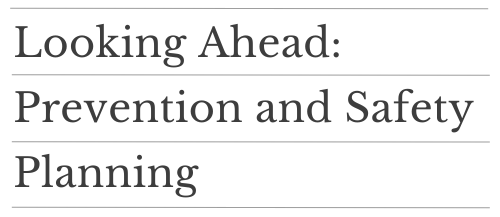Warning Signs, Brief Intervention and Postvention

Learn the Warning Signs: When to Intercede
These warning signs may mean that someone is at risk of suicide. Risk is greater if a behavior is new or has increased and seems related to a painful event or loss.
Immediate Warning Signs:
- Talking or writing about suicide
- Has a plan
- Expressing hopelessness about the future
- Making preparations for suicide (giving away belongings, writing a suicide note, looking for means to attempt suicide)
General Warning Signs:
- Feels like a burden or talks about being trapped
- Relationship difficulties/loss- familial, social, romantic
- Change in energy level- unusual fatigue/more energy
- Lack of concentration
- Changes in hygiene
- Increasing use of alcohol, drugs or other risky behavior
- Increasingly agitated, anxious, sad, angry
- Withdrawing from social activities
- Spending more time alone or isolating
- Experience of loss
- Academic Issues
- Taking dangerous risks

Ask directly: “Are you thinking about suicide?”
- Tell the person thinking about suicide that you are open to speaking about the topic.
- You may be the first person who has signaled it is okay.
- The question opens the door to an honest and non-judgmental dialogue which can relieve some of the pain the person is experiencing.
- Asking does not increase the person’s risk- you will not be giving them a new idea.
- Asking opens the door for the next step which is to LISTEN. Take the person seriously.
- Let them tell you about the reasons for their emotional pain.
Keep Them Safe: Establish immediate safety
- Have they already done something to try to kill themselves?
- Do they know how they would kill themselves?
- How prepared are they to act on their plan?
- How soon were they thinking of carrying out their plan?
- Do they have access to firearms?
- Put TIME and DISTANCE between the person and their chosen method.
Be There: Show your support
- Check-in by phone or in-person.
- Do what you said you would do for the person, but do not make promises you cannot or are not willing to keep.
- Listen, don’t lecture.
- Use phrases like:
- “I’m so grateful you’re sharing this with me.”
- “I care and I will help.”
- “Thank you so much for telling me.”
- “I want to work together to get you help.”
- Reflect what they share to let them know they have been heard.
Help Them Connect: 988
- Text, chat and call options are available.
- Ongoing support is essential.
- Contact resources like United Way 211, local community mental health providers, and/or the 988 Suicide & Crisis Lifeline.
Follow Up: See how they’re doing in the days/weeks/months following
- Phone, text, email- it doesn’t matter how! It just matters the person knows you still care.
- See if they have connected to the resources you already talked about.

Safety planning can help facilitate a conversation between yourself and someone considering suicide.
Safety planning is a preventative strategy for managing individual suicide risk and mental health crises. It is something we can do for ourselves or collaboratively with a loved one or mental health / healthcare professional. Using basic strategies and writing out a plan allows us to recognize existing protective factors and reduce risk factors during a crisis.


Youth Suicide Prevention
Warning Signs in Youth
- Sad, hopeless, tearful, crying
- Irritable, angry, hostile
- Loss of interest, apathy, withdrawn
- Fatigue or lack of energy
- Feeling worthless or guilty
- Feeling restless or agitated
- Changes in eating, sleeping, hygiene
If a child says nothing is wrong but has no explanation for depressed behavior- trust your instincts.
Encouraging kids to open up:
- Be loving and non-judgmental.
- Share specific concerns and why they worry you.
- Understand that they may be reluctant to open up about how they’re feeling.
- Offer support; be gentle but persistent.
- Listen without lecturing.
- Validate their feelings, remember that we all struggle sometimes.
Things you can say:
- “I care and will help.”
- “Thank you so much for telling me.”
- “I want to work together to get you help.”
- Reflect what they share to let them know they have been heard
If you think a child might be suicidal, ask directly: “Are you thinking about suicide?”
If they answer “yes”:
- Ask about a plan.
- Listen; all signs and statements about suicide must be taken seriously.
- Be non-judgmental and offer empathy.
- Do not leave them alone.
- Stop what you are doing and take immediate action.
- If they are your student: Contact the building administrator or designee.
- Connect them with professional help.
- Continuously follow up.
- Call the Suicide & Crisis Lifeline with them, 988.

If you have experienced the loss of a loved one to suicide, you don’t have to grieve alone. There are many support groups that meet in person and virtually.
- The Alliance of Hope Community Forum The Alliance of Hope was created by survivors for survivors. As a 501(c)3 charitable nonprofit, we provide online healing support and other services for people who are coping with the devastating loss to suicide.
- Parents of Suicides (POS) – Friends and Families of Suicides (FFOS)
- AFSP’s Website allows you to search your area to find support groups.
- Save.org also has a searchable database for support groups
- The Dougy Center provides support in a safe place where children, teens, young adults and their families grieving a death can share their experiences.
- LemonAid provides assistance paying for costs associated with the loss of loved ones to suicide, and help with emotional and resource support needs for Kansans.
